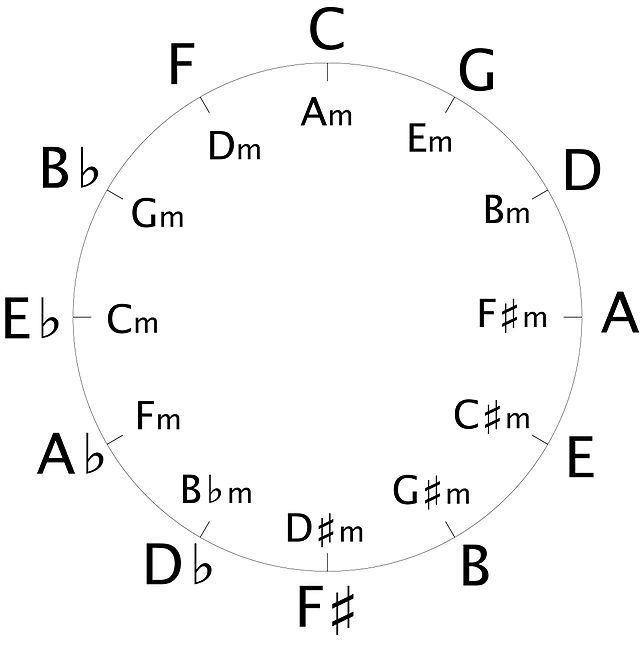Violins can be tuned in many different ways. In Arabic music, Violins are tuned using 4ths whereas in more conventional Western music, Violins are tuned in perfect 5ths.
The concept of perfect 5ths dates back to Pythagoras, and the circle of 5ths has lots of use in musical theory. However, the main advantages of tuning Violins in 5ths include universalizing tuning and enabling the Violinist to quickly move finger patterns between strings.
Read on to find out more about why Violins are tuned in 5ths.
Summary
Violins are mostly tuned in 5ths for speed of movement between strings, optimal ergonomics, and best sound resonance. Though other tuning options exist, this one is the most common in Western classical music because it best serves its playing style.
Table of Contents
What Does It Mean to Be Tuned in 5ths?
Tuning in 5ths means that the interval between consecutive strings is a perfect fifth. As an example, the two highest pitched strings on the Violin are A and E, with E being five notes (in the major scale) higher than A.
In violin, the strings are tuned in 5ths to G, D, A, and E respectively.
- Start out with the G string, the first violin string. On a G major scale, you play G, A, B, C, D, E, F#, G.
- The 5th note of a G major scale is D. The second string of a violin is a D string.
- The 5th note of a D major scale is A. The third string is an A string.
- The 5th note of an A major scale is E. So the fourth and final string is an E string.
What Are Perfect 5ths?
A perfect 5th is a musical interval. An interval is a difference in pitch between two notes.
A perfect 5th is a perfect interval. Other examples of perfect intervals include perfect 4ths, 5ths and octaves.
They are all part of a group called perfect intervals. Whilst there are historical theories dating back to Pythagoras, a perfect interval is where the two sounds being compared have frequencies that form a clean fraction when divided.
Perfect 5ths have a frequency ratio of 3:2 or very close to it. For example, a middle G has a frequency of 392 Hz, and a middle C (a perfect 5th lower) has a frequency of 261 Hz. If you divide these two numbers, you get a ratio of almost 3:2.
This is actually detectable by the human ear. Even before specific calculations were made, a human ear could distinguish that the two pitches are harmonious together.
This is why perfect intervals are associated with consonance, which means they’re pleasing to the ear and evoke feelings of calmness, as opposed to dissonance, which translates to harshness and irritability.
This is an excellent instructional video further explaining perfect intervals:
What Is The Circle of 5ths?
The circle of 5ths is a tool to visualize and understand the distance between major scales and their relationship to one another. It also simplifies how to transpose and harmonize between them. Think of it as the periodic table or color wheel but for musicians.
Here is a diagram of the circle of 5ths:

There are many versions of it, each with a different tool you can use when you’re composing, transposing, and harmonizing. It’ll also help visual learners “see” where they are in chords and what minor keys are relative to which major keys.
Here is an excellent instructional video on how the circle of fifths works:
Are Violins Ever Tuned in Other Ways?
Violins are occasionally tuned aside from the usual G-D-A-E. Different cultures and eras tuned the Violin in different ways.
For example, in classical Arabic music, the tuning is G-D-G-D, in Turkish music it’s G-D-A-D, whereas in Indian style, the tuning can be A-E-A-E.
Other tunings can be used in classical Western music, particularly in violin solos, where you’d want to give a different feel to the music. These alternate tunings are called scordatura, or cross-tuning for fiddle players.
Examples of this are endless, but here are a few:
- Violin Concerto No. 1, by Niccolò Paganini, the solo violin’s strings are tuned a semitone higher to match the E♭ major original key.
- Gustav Mahler, in the 2nd movement of his 4th Symphony, requires a scordatura violin soloist as well to give an unpolished sound.
- Igor Stravinsky’s The Firebird demands the whole first violin section to retune the E string, in order to play the introduction with a D major harmonic glissandi.
What Are the Advantages of Being Tuned in 5ths?
Aside from 5ths tuning being the standard for violin that stuck around as the instrument evolved, most violinists see that it’s the optimal tuning for a number of reasons.
It can provide speed while playing without having to move your hands around too much. Take the other examples of perfect intervals (perfect 4ths and octaves). Perfect 4ths only give you 3 note-per-string scales, which is fewer than the 4 notes provided by the 5ths. While octaves will have you moving your fingers very fast to accommodate the number of notes on the one string.
Another very good reason is the rich overtones 5ths tuning provides. Some violinists say that when you’ve successfully tuned a string and moved your bow across, it “opens up” a new level of resonance. And it’s palpable when you’re tuning your violin as we’ll discuss below.
Another, rather intuitive answer, is that we have four fingers available to play, which makes the 4-notes-per-string scales the most ergonomic, and so the tuning of the violin evolved to match.
Overall, the most practical and advantageous reason why violins are tuned in fifths was to create a universal way of tuning the instrument.
What Other Instruments Are Tuned in 5ths?
Tuning in 5ths seems to be reserved for smaller-sized string instruments like violas, mandolins, and tenor banjos. Cellos are also tuned in 5ths, probably to match the other instruments played with them in an orchestra.
Other strings like double bass, viola da gamba, and bass guitar are tuned in 4ths because of their different playing styles. However, a double bass can be tuned in 5ths as well to play some kinds of classical and jazz music.
How to Tune a Violin in 5ths?
There are two ways to tune a violin; just intonation and expressive intonation.
Just intonation minimizes the sharpness of the E string and the flatness of the G string, but it does compromise the resonance of the instrument.
Meanwhile, expressive intonation is used by concert violinists since it makes sharps higher and flats lower. This helps accentuate the sympathetic vibrations their instrument makes with the other strings.
If you’re a beginner and you want to tune your violin, first grab a digital tuner and set your C at 440 Hz. Adjust the pegs and/or fine tuners on your string and pluck it till the tuner indicates your A is in tune, then move to the D string and then the G and E.
More advanced players will advise you to “train your ear” to rely less on your digital tuner and listen for how the violin sounds when it’s in tune.
This can be quite challenging at first, but it’s ultimately doable since strings that aren’t in tune tend to warble. They have some sort of beat pattern that can be slower or faster depending on how close you are to being in tune.
As your strings are adjusted, when you bow any two strings together, like A and D for example, it should sound like you suddenly raised the volume on your violin as it “opens up.” This is a clear indication that you’ve done a good job.
However, make sure to check your strings every time before playing, since strings can go out of tune quite easily. There are some simple fixes to stop Violins from going out of tune, such as correct storage and slipping pegs.
The wooden pegs tend to turn on their own, which relaxes the strings and ruins your tuning. You can help them stay in place by using a peg compound that can help with the slipperiness.
Final Thoughts
“Why are violins tuned in 5ths?” Most players start to wonder why things are the way they are and what if they can be better.
Perfect intervals are wonderful phenomena that combine both physics and music together. And perfect fifths are considered the most consonant after octaves and unison, which tells you they’re something special.
